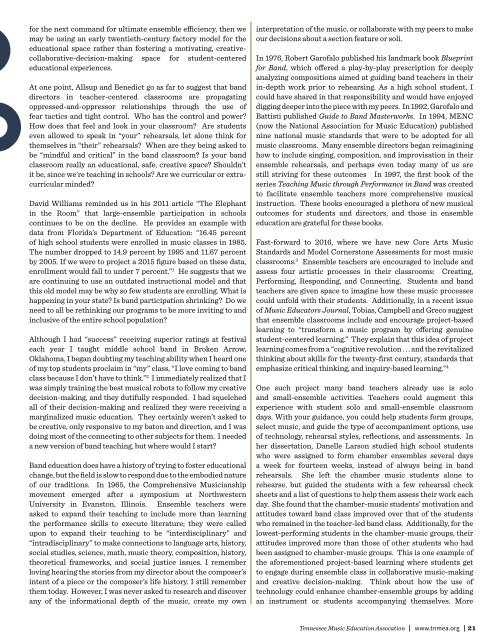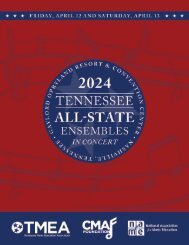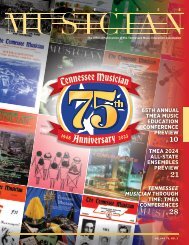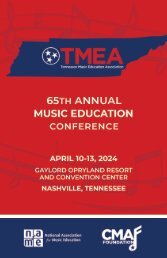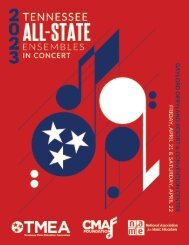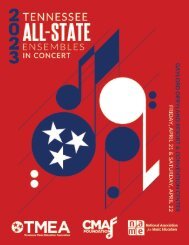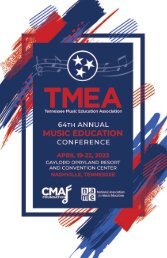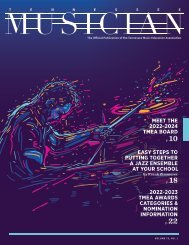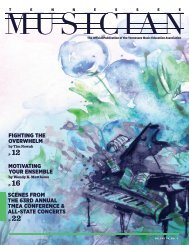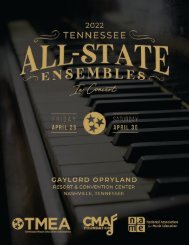Create successful ePaper yourself
Turn your PDF publications into a flip-book with our unique Google optimized e-Paper software.
for the next command for ultimate ensemble efficiency, then we<br />
may be using an early twentieth-century factory model for the<br />
educational space rather than fostering a motivating, creativecollaborative-decision-making<br />
space for student-centered<br />
educational experiences.<br />
At one point, Allsup and Benedict go as far to suggest that band<br />
directors in teacher-centered classrooms are propagating<br />
oppressed-and-oppressor relationships through the use of<br />
fear tactics and tight control. Who has the control and power?<br />
How does that feel and look in your classroom? Are students<br />
even allowed to speak in “your” rehearsals, let alone think for<br />
themselves in “their” rehearsals? When are they being asked to<br />
be “mindful and critical” in the band classroom? Is your band<br />
classroom really an educational, safe, creative space? Shouldn’t<br />
it be, since we’re teaching in schools? Are we curricular or extracurricular<br />
minded?<br />
David Williams reminded us in his 2011 article “The Elephant<br />
in the Room” that large-ensemble participation in schools<br />
continues to be on the decline. He provides an example with<br />
data from Florida’s Department of Education: “16.45 percent<br />
of high school students were enrolled in music classes in 1985.<br />
The number dropped to 14.9 percent by 1995 and 11.67 percent<br />
by 2005. If we were to project a 2015 figure based on these data,<br />
enrollment would fall to under 7 percent.” 1 He suggests that we<br />
are continuing to use an outdated instructional model and that<br />
this old model may be why so few students are enrolling. What is<br />
happening in your state? Is band participation shrinking? Do we<br />
need to all be rethinking our programs to be more inviting to and<br />
inclusive of the entire school population?<br />
Although I had “success” receiving superior ratings at festival<br />
each year I taught middle school band in Broken Arrow,<br />
Oklahoma, I began doubting my teaching ability when I heard one<br />
of my top students proclaim in “my” class, “I love coming to band<br />
class because I don’t have to think.” 2 I immediately realized that I<br />
was simply training the best musical robots to follow my creative<br />
decision-making, and they dutifully responded. I had squelched<br />
all of their decision-making and realized they were receiving a<br />
marginalized music education. They certainly weren’t asked to<br />
be creative, only responsive to my baton and direction, and I was<br />
doing most of the connecting to other subjects for them. I needed<br />
a new version of band teaching, but where would I start?<br />
Band education does have a history of trying to foster educational<br />
change, but the field is slow to respond due to the embodied nature<br />
of our traditions. In 1965, the Comprehensive <strong>Musician</strong>ship<br />
movement emerged after a symposium at <strong>No</strong>rthwestern<br />
University in Evanston, Illinois. Ensemble teachers were<br />
asked to expand their teaching to include more than learning<br />
the performance skills to execute literature; they were called<br />
upon to expand their teaching to be “interdisciplinary” and<br />
“intradisciplinary” to make connections to language arts, history,<br />
social studies, science, math, music theory, composition, history,<br />
theoretical frameworks, and social justice issues. I remember<br />
loving hearing the stories from my director about the composer’s<br />
intent of a piece or the composer’s life history. I still remember<br />
them today. However, I was never asked to research and discover<br />
any of the informational depth of the music, create my own<br />
interpretation of the music, or collaborate with my peers to make<br />
our decisions about a section feature or soli.<br />
In 1976, Robert Garofalo published his landmark book Blueprint<br />
for Band, which offered a play-by-play prescription for deeply<br />
analyzing compositions aimed at guiding band teachers in their<br />
in-depth work prior to rehearsing. As a high school student, I<br />
could have shared in that responsibility and would have enjoyed<br />
digging deeper into the piece with my peers. In 1992, Garofalo and<br />
Battisti published Guide to Band Masterworks. In 1994, MENC<br />
(now the National Association for Music Education) published<br />
nine national music standards that were to be adopted for all<br />
music classrooms. Many ensemble directors began reimagining<br />
how to include singing, composition, and improvisation in their<br />
ensemble rehearsals, and perhaps even today many of us are<br />
still striving for these outcomes In 1997, the first book of the<br />
series Teaching Music through Performance in Band was created<br />
to facilitate ensemble teachers more comprehensive musical<br />
instruction. These books encouraged a plethora of new musical<br />
outcomes for students and directors, and those in ensemble<br />
education are grateful for these books.<br />
Fast-forward to 2016, where we have new Core Arts Music<br />
Standards and Model Cornerstone Assessments for most music<br />
classrooms. 3 Ensemble teachers are encouraged to include and<br />
assess four artistic processes in their classrooms: Creating,<br />
Performing, Responding, and Connecting. Students and band<br />
teachers are given space to imagine how these music processes<br />
could unfold with their students. Additionally, in a recent issue<br />
of Music Educators Journal, Tobias, Campbell and Greco suggest<br />
that ensemble classrooms include and encourage project-based<br />
learning to “transform a music program by offering genuine<br />
student-centered learning.” They explain that this idea of project<br />
learning comes from a “cognitive revolution . . . and the revitalized<br />
thinking about skills for the twenty-first century, standards that<br />
emphasize critical thinking, and inquiry-based learning.” 4<br />
One such project many band teachers already use is solo<br />
and small-ensemble activities. Teachers could augment this<br />
experience with student solo and small-ensemble classroom<br />
days. With your guidance, you could help students form groups,<br />
select music, and guide the type of accompaniment options, use<br />
of technology, rehearsal styles, reflections, and assessments. In<br />
her dissertation, Danelle Larson studied high school students<br />
who were assigned to form chamber ensembles several days<br />
a week for fourteen weeks, instead of always being in band<br />
rehearsals. She left the chamber music students alone to<br />
rehearse, but guided the students with a few rehearsal check<br />
sheets and a list of questions to help them assess their work each<br />
day. She found that the chamber-music students’ motivation and<br />
attitudes toward band class improved over that of the students<br />
who remained in the teacher-led band class. Additionally, for the<br />
lowest-performing students in the chamber-music groups, their<br />
attitudes improved more than those of other students who had<br />
been assigned to chamber-music groups. This is one example of<br />
the aforementioned project-based learning where students get<br />
to engage during ensemble class in collaborative music-making<br />
and creative decision-making. Think about how the use of<br />
technology could enhance chamber-ensemble groups by adding<br />
an instrument or students accompanying themselves. More<br />
Tennessee Music Education Assocation | www.tnmea.org | 21


